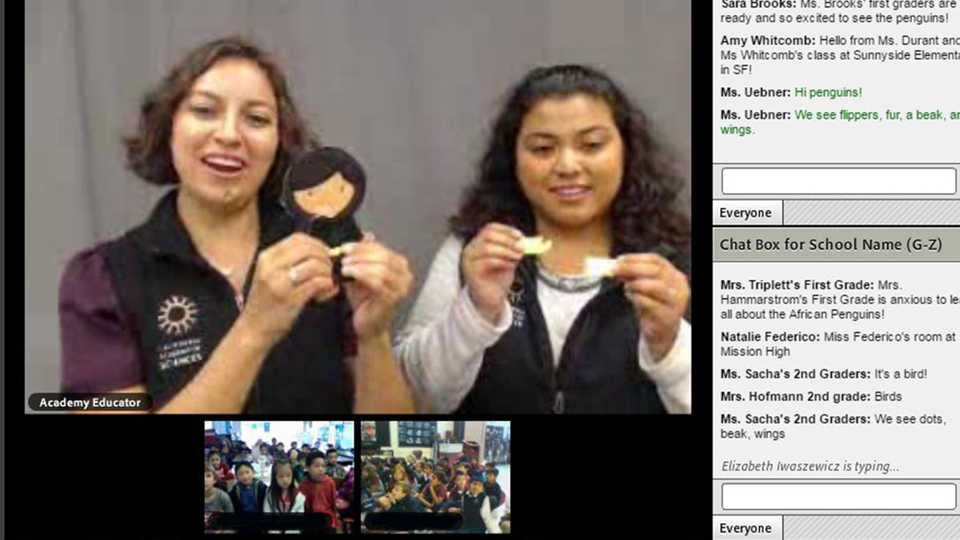
Recently students from over 60 classes from California and Connecticut connected with us online to celebrate African Penguin Awareness Day.
What do you get when you have over 60 classes visit a Penguin Colony virtually?
In this 45-minute program, Transitional Kindergartners – 3rd graders met with our science educators to explore the lives of South African Penguins. Students observed the penguins in our colony in order to learn about how the structure of their body parts help them survive in their native environment. Students explored what it was like to be a penguin by waddling and swimming like one. Finally, students had the chance to ask their questions on camera or through a chat box about penguins.
This is one example of our Special Live Events hosted online that connect museum science educators to classes who might not get to go on field trips. Science learning is important for everyone. The relevant, real-life skills that people develop when learning science help make everyone better problem-solvers and citizens. Events such as these help teachers connect their students with opportunities to learn science in a larger context, which is important because just like learning another language, science fluency requires immersive learning opportunities.
What were K-3 students most curious about?
Throughout the Penguin Awareness Day program students were encouraged to ask questions. Some of the most-asked questions are below:
- Why are they black and white? Penguins are black and white as a type of camouflage called counter shading. If you were looking at a penguin in the water and looking at the back it would blend into the bottom of the ocean. If you were looking at a penguin in the water and looking at its stomach it would blend into the sunshine reflecting on the top of the ocean.
- Why are they tagged with arm bands? The arm bands help the biologist tell which penguin is which. If the arm band is on the right wing it is a male penguin. If the arm band is on the left wing it is a female penguin. If a male and female penguin have the same colored band than they are a bonded pair.
- How many African penguins live in the wild? Historically there were over 1.5 million African Penguins. Scientists estimate there are now only 75,000-80,000 African penguins left in the wild. Because of the decrease in the number of penguins they are listed as an endangered species. This allows them to get more help and protection.
- How can we help wild African Penguins? People like you can have beneficial impacts on penguins and the ecosystems these birds depend on. You can help penguins by eating seafood that is caught sustainably. This means that the seafood is caught in a way that allows other animals to get what they need from the environment too. If the seafood is not caught sustainably penguins and other animals are not able to survive because they don’t have enough food. To learn more and participate check out Seafood Watch at www.seafoodwatch.org. Additionally, you can also learn more about what local people do to help penguins in the wild at SANCCOB. Scientists and the people who live nearby penguins are helping by making sure that penguin habitat isn’t taken over by people’s buildings, they help prevent and clean up from oil spills, and they do research to learn about how seasonal weather patterns are changing and how that effects molting and breeding seasons.
What are some things you think you can do to help the wild plants and animals that live near you?
Teacher thoughts…
“My special day class of students with moderate disabilities loved this program and were very attentive throughout. They were very captivated by the technology, as well as by seeing the Penguins.”
-Special Day Class in San Francisco
“Most students had never seen a real penguin before. They thought they all lived in the snow. Loved it! Thanks!!”
-Kingswood K-8
“Thank you for this wonderful opportunity. Amazing discoveries were made by many of my students and penguins was so age appropriate for my kindergartners. Thank you again!”
- Alvarado Elementary School
Join us for another Special Live Event
We are looking forward to many more programs this winter and spring with the Academy collections, planetarium staff, and our own Academy scientists!
If you are interested in seeing our next live program join us on October 28th for Skulls! Halloween Edition. And check back often – we update our calendars regularly.